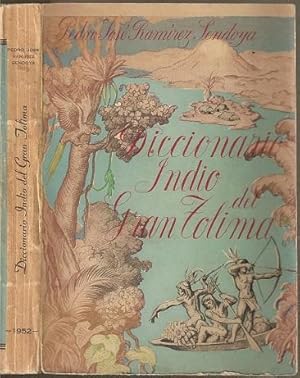RAMIREZ SENDOYA, PEDRO JOSE 1897 1966 (1 resultados)
Tipo de artículo
- Todo tipo de artículos
- Libros (1)
- Revistas y publicaciones
- Cómics
- Partituras
- Arte, grabados y pósters
- Fotografías
- Mapas
-
Manuscritos y
coleccionismo de papel
Condición
- Todo
- Nuevos
- Antiguos o usados
Encuadernación
- Todo
- Tapa dura
- Tapa blanda
Más atributos
- Primera edición
- Firmado
- Sobrecubierta
- Con imágenes del vendedor
- Sin impresión bajo demanda
Ubicación del vendedor
Valoración de los vendedores
-
Diccionario Indio del gran Tolima. Estudio Lingstico y Etnogrfico sobre dos mil palabras indgenas del Huila y del Tolima
Publicado por Editorial Minerva, Bogata, 1952
Librería: The Book Collector, Inc. ABAA, ILAB, Fort Worth, TX, Estados Unidos de America
Libro Original o primera edición
Soft cover. Condición: Very Good. 1st Edition. xxxix+282+[6 plate] pages with diagrams and bibliography. Royal octavo (9 1/2' X 6 3/4") bound in original publisher's pictorial wrappers. First edition. The Pijao people lived in Tolima during pre-Columbian times. The name of the department comes from the Pijao word for "snowed". The Panches, from the Pijao liguistic family, were also settled here, reaching the region beyond the Magdalena valleys. Renowned as fierce warriors, the Panches are widely known for fighting the Muisca over the control of emerald mining territories. They fought against a Spanish-Muisca coalition and were ultimately defeated in the Battle of Tocarema in 1537. Spanish colonization of the region began in 1537 with Sebastián de Belalcázar travelling from the city of Cali to be with his colleague, Gonzalo Jiménez de Quesada, in Bogota. On its way, Belarcázar founded the settlement that would become eventually become known as Ibagué. Belarcázar traveled until he reached the site of Flandes in Tolima before arriving at Bogota. The definitive foundation began with Captain Andrés Lopez de Galarza who founded the city of Ibagué and the site on which the municipality of Cajamarca would be based, in the west of the department. These two cities would become an important part of the "coffee axis". Pedro Jose Ramirez Sendoya as a Colombian priest and researcher, especially dedicated to the study of indigenous cultures originating in the department of Tolima in Colombia. He was born in the former province of Neiva, known since 1906 as Huila , south of Gran Tolima. After becoming a priest he traveled to Europe to further his studies in theology and social sciences. Pedro Jose Ramirez Sendoya focused his studies on the indigenous cultures of his native province, which he had a deep love, because of his belief that research on these cultures had not been addressed in sufficient depth, his studies revolved around the language of the people pijao with innovative theories for their time based on the study of writings of priests who participated in the Spanish colonization. Among his published works include the Diccionario indio del Gran Tolima (1952) which is a linguistic and ethnographic study of the 2000 indigenous people of Huila and Tolima and Refranero comparado del Gran Tolima(1952). Condition: Wrappers soiled with some edge wear, corners bumped else a very good copy.


